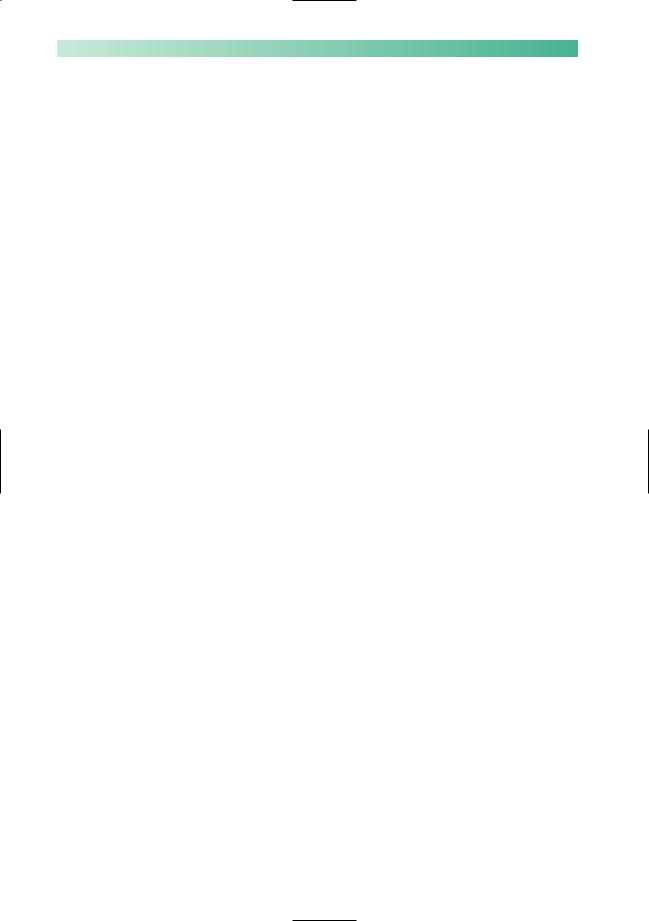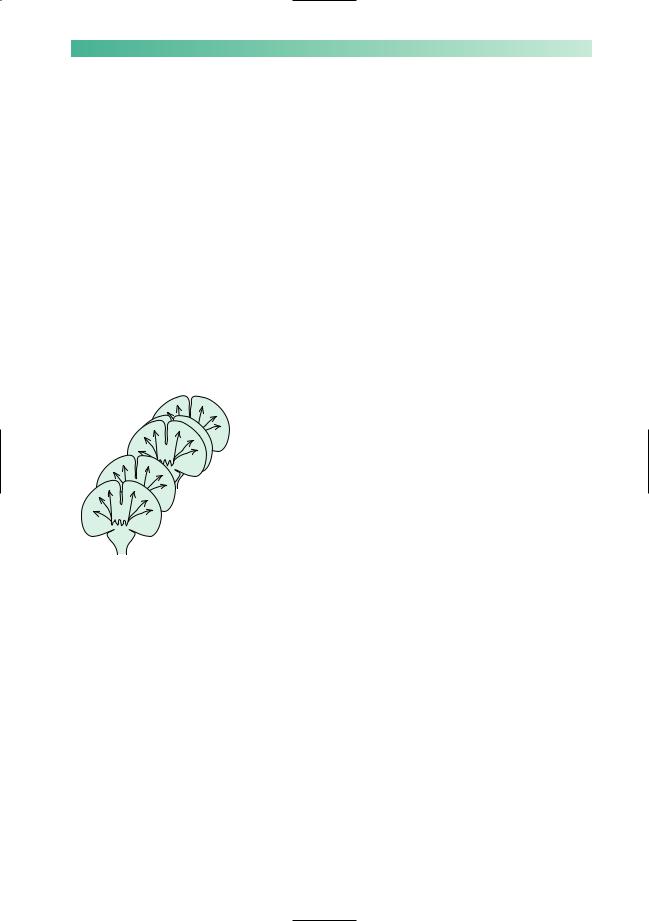
Wilkinson. Essential Neurology 2005
.pdf
200
Epilepsy syndromes
There are a large number of recognizable epilepsy syndromes, which are mainly rare, but two require special mention.
Juvenile myoclonic epilepsy
This is the commonest cause of tonic–clonic seizures starting in teenagers. It is a form of primary generalized epilepsy, so the tonic–clonic seizures come on without warning. They often follow a late night with too much alcohol. The patient may not volunteer the characteristic history of myoclonic seizures unless asked, having thought that their messy breakfasts were due to clumsiness rather than epilepsy. Similarly their absence seizures may have been attributed to day-dreaming. Crucially, juvenile myoclonic epilepsy is not usually fully controlled by carbamazepine or phenytoin, but it is by sodium valproate or lamotrigine. It is upsetting for all concerned when patients receive the wrong treatment for many years, with all the disability that attends poorly controlled epilepsy.
Lennox–Gastaut syndrome
Lennox (no relation) and Gastaut described one of the most severe forms of so-called epileptic encephalopathy, where a range of metabolic and genetic disorders of brain development give rise to severe learning disability and epilepsy. In addition to all the seizures types described above, patients with Lennox– Gastaut syndrome (LGS) may have seizures characterized by isolated tonic or clonic phases. They also experience a very distressing type of seizure called atonic seizures, in which there is abrupt loss of consciousness, muscle power and tone. The patient falls abruptly, often injuring his head or face. The prognosis in LGS is very poor, although some of the newer anticonvulsants have a partial effect in reducing seizure frequency.
CHAPTER 12

EPILEPSY |
201 |
Non-epileptic attacks
The differential diagnosis of epilepsy, including non-epileptic attacks of psychogenic origin, has been discussed in Chapter 11 (see p. 180). It is worth repeating here that non-epileptic seizures generally resemble tonic–clonic seizures but tend to be more prolonged, to involve more coordinated and purposeful movements (arching the back repetitively, turning the head from side to side, grasping attendants) and to preserve reflexes which are lost in tonic–clonic seizures (pupil, lash and tendon stretch reflexes and flexor plantar responses). Cyanosis does not occur unless the diagnosis has been missed and the patient has been given sufficient intravenous lorazepam or diazepam to suppress respiration. Because of the risk of iatrogenic respiratory arrest, it is important, but sometimes difficult, to distinguish lengthy non-epileptic attacks from status epilepticus.
Status epilepticus
Unless otherwise stated the term status epilepticus indicates the occurrence of one tonic–clonic seizure after another without recovery of consciousness between attacks. During tonic–clonic seizures, there exists a state of increased cerebral metabolism and oxygen requirement and decreased respiratory efficiency and cyanosis. If further tonic–clonic seizures occur at short intervals, it is easy to understand that increasing metabolic acidosis and oedema will occur in the brain, and progressively increasing coma will overtake the patient. There is evidence that, even if hypoxia and metabolic acidosis are prevented, seizures themselves can cause permanent brain damage if they last more than 1 hour (as a toxic consequence of excessive release of excitatory neurotransmitters). Hence, urgent control of seizures and attention to respiration are required in patients with tonic–clonic status, usually needing admission to an intensive care unit. The treatment is discussed in more detail on p. 208. Even with careful management, status epilepticus has a significant mortality rate and it is common for survivors to have new cognitive or physical difficulties or more refractory epilepsy.

202
Diagnosis
Clinical history and a good witness’s account
Epilepsy is a difficult condition to diagnose, and mistakes (both underdiagnosis and overdiagnosis) are not infrequent. Certainty of diagnosis in patients with epilepsy depends mainly on the establishment of a clear picture of the features of the attack both from the patient and from a witness. This applies to the diagnosis of any sort of blackout, as emphasized in Chapter 11. One has to go through the precise details of how the patient felt before, during (if conscious) and after the attack, and also obtain a clear description of how the patient behaved during each stage from a witness. One cannot overstate the importance of the clinical history in evaluating attacks. Investigations, such as EEG, should be used to support a diagnostic hypothesis based on the clinical information. Diagnostic certainty is always much more difficult in unwitnessed episodes of loss of consciousness.
The following comments can be made about the differential diagnosis of the different forms of epilepsy.
•Tonic–clonic seizures have to be differentiated from the other causes of attacks of loss of consciousness mentioned in Chapter 11 (see Fig. 11.2, p. 176). Cardiovascular disorders are the main consideration (simple faints and vasovagal syncope in young patients, arrhythmias and postural hypotension in older patients). Confusion often arises because of the brief flurry of myoclonic jerks that sometimes accompany syncope of any cause. Non-epileptic attacks of a psychogenic kind are a common source of diagnostic difficulty in specialist clinics. Diabetics on treatment of any sort should prompt one to think of hypoglycaemia. In general, tongue biting, irregular noisy breathing, strong convulsive movement, incontinence, post-ictal confusion and limb pains all suggest tonic–clonic epilepsy.
•Absence seizures may be confused with absent-minded daydreaming, or with wilful inattention of a young person to his environment. The sudden nature of the start and finish of the trance, switch-like, typifies absence epilepsy.
•Focal motor seizures do not really have a differential diagnosis.
•Focal sensory seizures may be difficult to differentiate from episodes of transient cerebral ischaemia, but are usually shorter and more frequent, and cause tingling rather than numbness.
•Frontal lobe seizures can be confused with dystonia (see Chapter 5, p. 75) and can appear so bizarre that they are thought to have a behavioural basis.
CHAPTER 12
Listen to the patient
Listen to a witness
•in detail
•in person
•on the phone
•via letter

EPILEPSY
Think about the cause
•Family history
•Past history
•System review
•Alcohol history
•Drug history
•Focal neurological symptoms or signs
203
•Temporal lobe seizures mainly have to be distinguished from anxiety and panic attacks.Attacks which are provoked in any way, or which last more than a few minutes, are unlikely to be due to temporal lobe epilepsy. Attacks which involve unusual behaviour requiring alert, clear thought and/or well-coordinated physical behaviour (fighting, shoplifting) are most unlikely to be due to epilepsy.
Establishing the cause of epilepsy
Apart from accurate information regarding the attacks, there is further information to be elucidated at the interview and examination. If the attacks are thought to be epileptic, an enquiry should be mounted as to the cause of the epilepsy. Primary generalized epilepsy (primary generalized tonic–clonic, absence or myoclonic seizures, with or without photosensitivity) is familial, so questioning may reveal other members of the family who suffer from epileptic attacks. Any form of focal epilepsy (and some cases with no apparent focal features) reflects the presence of intracranial pathology. Most commonly, this pathology is an area of scarring subsequent to some previous active pathology, though sometimes epileptic attacks may occur when the pathological process is in the active phase:
•following birth trauma to the brain;
•following trauma to the skull and brain later in life;
•during or following meningitis, encephalitis or cerebral abscess;
•at the time of, or as a sequel to, cerebral infarction, cerebral haemorrhage or subarachnoid haemorrhage;
•as a result of the inevitable trauma of neurosurgery. Sometimes, the epileptic attacks are caused by biochemical
insults to the brain, rather than by localized physical disease, such as:
•during alcohol or drug withdrawal;
•during hepatic, uraemic, hypoglycaemic comas;
•whilst on major tranquillizing or antidepressant drugs.
At the front of one’s mind must be the possibility that the pa-
tient’s epilepsy is an early symptom of a brain tumour. Brain tumours are not a common cause of epilepsy, but they are not to be missed. Epilepsy of adult onset, especially if focal and/or associated with evolving abnormal neurological signs, should initiate strong thoughts about the possibility of a tumour.

204 |
CHAPTER 12 |
Physical examination
Physical examination is clearly important since it may reveal abnormal neurological signs which indicate evidence of:
•previous intracranial pathology;
•current intracranial pathology;
•evolving intracranial pathology as indicated above.
EEG and other investigations
The EEG is not a test for epilepsy. In the appropriate clinical setting (i.e. a patient with a history suggestive of epilepsy) it may provide additional support for the diagnosis and help in distinguishing between the generalized and focal types of epilepsy. But remember:
•10% of the normal population show mild, non-specific EEG abnormalities, such as slow waves in one or both temporal regions;
•30% of patients with epilepsy will have a normal EEG between their attacks (falling to 20% if the EEG includes a period of sleep).
In other words, the EEG can mislead through both false positives and false negatives, and must be requested and interpreted with care. Prolonged ambulatory EEG recording (an immensely laborious activity) can be useful in very difficult cases with frequent attacks, allowing the EEG to be sampled during the attack itself. But even here there is a false-negative problem, with 10% of focal seizures arising deep in a fold of the cerebral cortex and failing to give rise to abnormal discharges on the EEG.
Imaging of the brain, preferably with MR rather than CT scanning, is an important part of the assessment of focal epilepsy, and in cases where the type of epilepsy is uncertain. It is probably unnecessary in patients with primary generalized epilepsy confirmed by EEG.
The other routine tests (glucose, calcium, ECG) are very rarely informative.
Summary of the stages in diagnosis in a patient with epilepsy
1. |
Listen to the patient. |
5. |
Investigate by EEG, often by MR brain scan, |
2. |
Listen to witnesses. |
|
sometimes by other tests. |
3. |
Wonder why the patient has epilepsy. |
6. |
Assess patient reaction and the consequences of |
4. |
Try to establish a cause: |
|
the diagnosis of epilepsy in his or her life. |
•from the history;
•from the examination.

EPILEPSY |
205 |
•Airway
•Prevent injury
•Await recovery
•Reassurance
•Listen to patient’s anxieties
•Listen to family’s anxieties
•Correct any wrong preconceptions
Management
‘On the spot’
If somebody suddenly has a tonic–clonic fit, people close at hand should:
1.look after the patient’s airway (by putting the patient into the recovery position when you can and pulling the jaw forward);
2.prevent self-injury during strong convulsive movements (by keeping the patient away from hard, sharp or hot objects).
Relatives of newly diagnosed epileptic patients certainly appreciate advice of this sort. In an adult, one would generally wait for the convulsions to cease and for the patient to regain consciousness. If one can establish that the patient is subject to epileptic fits, no further medical action is required. If the patient has never had a fit before, and especially if there are focal features to the fits or post-ictal stage, further medical advice will be required either immediately or in the next few days. In children with febrile convulsions, diazepam may be administered per rectum if it is available, and further medical attention should be sought if the convulsion has not stopped (with or without diazepam) within 5 minutes.
Explanation
Generally supportive comments and explanation about epilepsy, appropriate to the level of intelligence of the patient and his relatives, constitute the first steps in the management of newly diagnosed epilepsy. The actual word epilepsy greatly upsets some families. It is a good idea to ask the patient and relatives what epilepsy means to them as a starting point for explanation and reassurance. Not uncommonly, it is the relatives, rather than the patient, who are more anxious about attacks involving unconsciousness. They need to be reassured that although the epileptic attack may have looked profoundly life-threatening, death during epileptic convulsions is actually extremely rare. Associations of epilepsy with mental subnormality, madness, brain tumours, epileptic ‘homes’, incurability, transmission to the next generation, etc. are all likely to be introduced during this phase of explanation, and it is important that the doctor has a chance of correcting preconceived ideas in the patient or his family at the outset.
The facts that young people tend to grow out of their tendency to epilepsy, and that epilepsy can be controlled by drugs in the majority of cases, need to be clearly stated.

206
Drug therapy
Positive motivation towards taking anticonvulsant drugs, which have side-effects, and which may need to be taken regularly for several years, is not automatic in patients with epilepsy. It will be optimized by careful explanation about the drugs, and allowing time for the patient to express his feelings about the prospect of taking the pills regularly.
You need to help the patient to decide which drug has the best chance of controlling the seizures with the least risk of sideeffects that would be unacceptable from their point of view. Patients will prioritize possible side-effects differently depending on their circumstances: sedation may be a major concern to an academic; teratogenic hazard may be the greatest worry to a woman who is planning a family. Once you have chosen a drug, this should be introduced gradually with the aim of finding the smallest dose that completely suppresses the seizures. If the patient builds the dose up to a level that is causing side-effects and is still having seizures, then you need to move on to another drug. Serum anticonvulsant levels are not an important part of this titration process, but can be a way of making sure the patient is actually taking the pills.
Primary generalized epilepsy usually responds to drug treatment. The first-line drugs are sodium valproate and lamotrigine. Myoclonus often responds to the addition of clonazepam, and absences may respond specifically to ethosuximide. There are several second-line options, including phenobarbitone, topiramate and levetiracetam.
The choice of drugs for focal epilepsy is even wider, but only 80% of patients achieve complete control. The first-line drugs are carbamazepine, sodium valproate and lamotrigine. If none of these drugs work on their own, then the possibility of surgical treatment should be considered (see p. 210) before moving on to a combination of a first-line and a second-line drug (phenytoin, topiramate, levetiracetam, gabapentin, phenobarbitone, etc.). If the patient responds to the combination, think about withdrawing the first-line drug to see if control is maintained on the second-line drug alone. In general, most patients prefer to take a single drug because this reduces the risk of side-effects; from the doctor’s point of view, it also reduces the risk of interactions between the two drugs and, in the case of those anticonvulsants metabolized by the liver, interactions with other drugs such as the oral contraceptive and warfarin.
Most anticonvulsants have both idiosyncratic (occasional and unpredictable) side-effects and dose-dependent ones. The most important side-effects of the first-line drugs are shown in the table on the next page. Teratogenicity (for example neural tube defects) is a serious concern when treating young women.
CHAPTER 12

EPILEPSY |
207 |
|
|
|
|
|
|
|
|
|
Dose-dependent |
Approximate |
|
|
|
Idiosyncratic side-effects |
side-effects |
teratogenic risk |
|
|
|
|
|
|
|
|
Valproate |
Weight gain, transient hair loss, |
Tremor, sedation |
>10% |
|
|
|
liver dysfuction |
|
|
|
|
Carbamazepine |
Rash, hyponatraemia |
Ataxia, sedation |
5% |
|
|
Lamotrigine |
Rash, influenza-like symptoms |
Sedation |
2–3% |
|
|
|
|
|
|
|
|
|
|
|
|
|
•Cool the child
•Rectal diazepam
•Consider meningitis
They should be counselled about this before starting treatment and again before any planned pregnancy. Folate supplements may reduce some of this risk.
It is generally possible to treat most patients with a twicedaily regimen (phenobarbitone, phenytoin and slow-release preparations of sodium valproate can be given once daily). This helps patients to remember their pills. Sticking to a thrice-daily schedule is very difficult.
Once anticonvulsant treatment is started, it is usual to maintain the treatment for a minimum of 2 or 3 years. If the seizures have been fully controlled, treatment can be withdrawn gradually but there is a high risk (about 40% overall) of seizures returning. The risk is much higher in some forms of epilepsy such as juvenile myoclonic epilepsy, in patients where it has taken several different drugs to achieve control, and where the epilepsy was caused by a structural brain lesion that is still present. Even patients with lower risk may prefer to stay on treatment rather than take a chance of losing their driving licence by having another attack.
Febrile convulsions
The main things to remember here are the early use of rectal diazepam, steps to cool the child (including paracetamol), correct management of any underlying infection (with particular consideration to the possibility of meningitis) and reassurance of parents about the benign nature of febrile convulsions.

208
Status epilepticus
Any form of status epilepticus is an indication for hospitalization to establish control of the seizures, but in the case of tonic–clonic status the problem is a medical emergency requiring admission to an intensive care unit. There are three main directions of treatment of grand mal status:
1.Routine care of the unconscious patient (see Chapter 11, p. 187).
2.Control of seizure activity in the brain. This means the maintenance of the patient’s normal anticonvulsant regime, supplemented by the use of intravenous anticonvulsants; diazepam or lorazepam early; phenytoin or phenobarbitone if seizures persist; thiopentone to produce general anaesthesia if seizures have failed to come under control within 60 minutes.
3.Maintenance of optimal oxygenation of the blood. This may mean the use of oxygen and an airway, but may be the main indication for anaesthesia, paralysis and ventilation. It is important to remember the control of seizure activity in the brain of the paralyzed. Vigorous anticonvulsant therapy must be continued.
Sensible restrictions
Until satisfactory control of epileptic attacks has been established, and for a little while longer, it is important for patients with most forms of epilepsy to be aware of the dangers of bathing, driving, riding a bicycle, heights, open heavy machinery, swimming and water sports. Advice to each patient has to be individualized, bearing in mind the type and frequency of his epileptic attacks. In the UK, the driving licensing authorities have definite guidelines for patients and doctors to follow, and it is the doctor’s role to make sure that the patient understands where he stands in relation to these. A patient who has had one or more attacks of epilepsy has to refrain from driving until 1 year has elapsed, regardless of whether the patient is on medication or not. This is the general rule in the UK, which has exceptions for nocturnal attacks and ‘provoked’ attacks. Very gentle but firm explanation is often required when pointing out the need for these restrictions.
Most patients with photosensitive epilepsy can attend discos where lights flash at rates too slow to stimulate epilepsy. Such patients should avoid video games and sit well back from the TV screen.
CHAPTER 12
•Emergency admission
•Care of the unconscious patient
•Continue and intensify anticonvulsant therapy i.v. benzodiazepine
i.v. phenytoin i.v. barbiturates
•Maintain oxygenation
•Driving
•Other potentially dangerous pursuits
•Understand frustration

EPILEPSY
Occupation
The financial benefits and personal prestige of working are important in the life of a patient with epilepsy, just as for everybody else. Nevertheless, it is more difficult for people with epilepsy to become employed. Some occupations are completely closed to patients with epilepsy, e.g. jobs requiring an HGV or PSV driving licence, and jobs in the armed forces, police or fire services. Some occupations may be very difficult for patients with incompletely controlled epilepsy, e.g. teaching, working with young children, nursing, and working near fire or water, at heights, or around unguarded machinery. Individual employers may need education and encouragement to accept that their employee with epilepsy can continue to work normally. In many countries disability discrimination legislation is helping to strengthen their resolve.
Special considerations in women with epilepsy
1.As already mentioned, the metabolism and transport systems of anticonvulsant drugs interact with those of oral contraceptive drugs, so special advice and monitoring are necessary if the two sorts of medication are to be taken concurrently.
2.All anticonvulsant drugs seem to be teratogenic to some extent. Stopping all medication and experiencing uncontrolled epilepsy during pregnancy may pose a greater risk to mother and fetus, although scientific data are extremely scanty. The aim should probably be to control all but the mildest forms of epilepsy using a single drug of low teratogenicity, in the lowest effective dose. The metabolism of most anticonvulsant drugs is increased during pregnancy, so drug level monitoring may show the need for slightly increased anticonvulsant dosage during pregnancy.
3.Most anticonvulsants appear in the mother’s milk during lactation, but not in quantities that affect the neonate. Mothers on anticonvulsants should breast feed if this is their wish.
4.Focal epilepsy, due to an epileptogenic cortical scar, is not an hereditary condition. Idiopathic, primary generalized, epilepsy is a familial condition so a little genetic counselling may be necessary in such cases. The risk of epilepsy in a child born to a couple, one of whom suffers from idiopathic epilepsy, is small. If both parents suffer from epilepsy, the risk becomes much greater (up to 1 in 4).
5.Care of infants and toddlers may be difficult for a parent who is unlucky enough to suffer from epileptic attacks which remain frequent despite drug therapy.
209
•Interaction of anticonvulsants and oral contraceptives
•Teratogenicity of anticonvulsants
•Genetics
•Breast feeding
•Childcare
